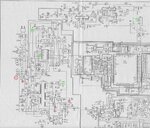AMSA84
Advanced Member level 2
- Joined
- Aug 24, 2010
- Messages
- 577
- Helped
- 8
- Reputation
- 16
- Reaction score
- 8
- Trophy points
- 1,298
- Location
- Iberian Peninsula
- Activity points
- 6,178
Hello there guys.
I am trying to repair my television (Sharp 70ES03S) and I am with a doubt here.
I have been told that we cannot mix the grounds from the power supplies, the primary and secondary. However, when looking to the schematic I have notice that the ground from the primary power supply appears in some components in the secondary and in the rest of the components in the low-voltage side. Please see the picture annexed.

The circles with red color are those that I was referring to. (of course there are other, but just to make the example valid I have selected those) The green circles represent other ground.
Perhaps I am confused, and if I am mixing all up I would appreciate that someone could explain me what are the differences and in case that I want to measure the voltage at the capacitor C720 how could I do it.
I am trying to repair my television (Sharp 70ES03S) and I am with a doubt here.
I have been told that we cannot mix the grounds from the power supplies, the primary and secondary. However, when looking to the schematic I have notice that the ground from the primary power supply appears in some components in the secondary and in the rest of the components in the low-voltage side. Please see the picture annexed.

The circles with red color are those that I was referring to. (of course there are other, but just to make the example valid I have selected those) The green circles represent other ground.
Perhaps I am confused, and if I am mixing all up I would appreciate that someone could explain me what are the differences and in case that I want to measure the voltage at the capacitor C720 how could I do it.
